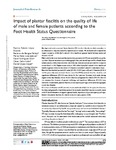Mostrar o rexistro simple do ítem
Impact of plantar fasciitis on the quality of life of male and female patients according to the Foot Health Status Questionnaire
| dc.contributor.author | López-López, Daniel | |
| dc.contributor.author | Palomo-López, Patricia | |
| dc.contributor.author | Becerro-de-Bengoa-Vallejo, Ricardo | |
| dc.contributor.author | Losa Iglesias, Marta Elena | |
| dc.contributor.author | Rodríguez Sanz, David | |
| dc.contributor.author | Calvo-Lobo, César | |
| dc.date.accessioned | 2022-03-14T13:11:17Z | |
| dc.date.available | 2022-03-14T13:11:17Z | |
| dc.date.issued | 2018-04 | |
| dc.identifier.citation | Palomo-López P, Becerro-de-Bengoa-Vallejo R, Losa-Iglesias ME, Rodríguez-Sanz D, Calvo-Lobo C, López-López D. Impact of plantar fasciitis on the quality of life of male and female patients according to the Foot Health Status Questionnaire. J Pain Res. 2018;11:875-880 https://doi.org/10.2147/JPR.S159918 | es_ES |
| dc.identifier.uri | http://hdl.handle.net/2183/29984 | |
| dc.description.abstract | [Abstract] Background and purpose: Plantar fasciitis (PF) is a foot disorder in adults secondary to an inflammatory response caused by repetitive micro-trauma. We evaluated and compared the impact on quality of life (QoL) related to foot health and general health between males and females with PF. Methods: In this cross-sectional descriptive study, patients with PF were recruited from a podiatry clinic. Physical examination, sociodemographic data, and the self-reported Foot Health Status Questionnaire (FHSQ) were recorded. The FHSQ has three sections and provides two composite scores from 0 to 100. Higher scores (close to 100) reflect better QoL related to foot health and health in general; lower scores (close to 0) denote a worse QoL related to these health items. Results: One hundred patients (49 males [42.38 ± 14.065 years old] and 51 females [43.90 ± 14.305 years old]) were recruited. Section one of the FHSQ evaluates four foot domains, and significant differences (P<0.05) were shown for foot pain and footwear, with males having higher scores than females, but not for foot function and general foot health (P>0.05). Section two assesses four domains of general wellbeing, and significant differences (P<0.05) were shown for overall health, physical function, social capacity, and vigor, with males having higher scores than females. Conclusion: Females with PF showed a worse health-related QoL for foot pain, foot function, footwear, and general foot health than males. A better health-related QoL was also shown for males with PF than for females with regard to general health, physical activity, social capacity, and vigor. | es_ES |
| dc.language.iso | eng | es_ES |
| dc.publisher | Dove Press | es_ES |
| dc.relation.uri | https://doi.org/10.2147/JPR.S159918 | es_ES |
| dc.rights | Atribución-NoComercial 3.0 España | es_ES |
| dc.rights.uri | http://creativecommons.org/licenses/by-nc/3.0/es/ | * |
| dc.subject | Plantar fasciitis | es_ES |
| dc.subject | Fascitis plantar | es_ES |
| dc.subject | Foot health status | es_ES |
| dc.subject | Salud podológica | es_ES |
| dc.subject | Foot pain | es_ES |
| dc.subject | Dolor en el pie | es_ES |
| dc.subject | Quality of life | es_ES |
| dc.subject | Calidad de vida | es_ES |
| dc.title | Impact of plantar fasciitis on the quality of life of male and female patients according to the Foot Health Status Questionnaire | es_ES |
| dc.type | info:eu-repo/semantics/article | es_ES |
| dc.rights.access | info:eu-repo/semantics/openAccess | es_ES |
| UDC.journalTitle | Journal of Pain Research | es_ES |
| UDC.volume | 11 | es_ES |
| UDC.startPage | 875 | es_ES |
| UDC.endPage | 880 | es_ES |
Ficheiros no ítem
Este ítem aparece na(s) seguinte(s) colección(s)
-
GI-UDISAP - Artigos [196]






